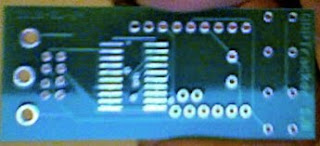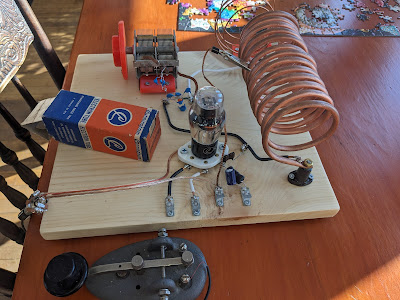Satpack PCB version 1.0
 PCBs for the satpack project arrived from BatchPCB.com about three weeks ago. These are designed to mate with the appropriate pins on a Arduino Mini Pro, and to provide that Arduino with access to the realtime clock, piezoelectric speaker, buttons and mini-din 8 connector required to control a recent Yaesu radio. To the right is one side of the design, the critical side that mates onto the Arduino. The boards are made from this design, but it ought not to be used, due to the errors described below.
PCBs for the satpack project arrived from BatchPCB.com about three weeks ago. These are designed to mate with the appropriate pins on a Arduino Mini Pro, and to provide that Arduino with access to the realtime clock, piezoelectric speaker, buttons and mini-din 8 connector required to control a recent Yaesu radio. To the right is one side of the design, the critical side that mates onto the Arduino. The boards are made from this design, but it ought not to be used, due to the errors described below.First, I have to say I was quite pleased with BatchPCB. Their website keeps you informed of the progress of your project, which in my case took about 25 days from order to arrival at my mailbox. If you can keep your project small, as this one is, it will be very affordable. My happiest surprise with BatchPCB was that the shipping charges -- indicated, as usual right at the end of the check-out process -- were very reasonable, especially for a destination outside the USA. I'm really tired of companies overcharging shipping, and I think it eventually lowers the impression of the business. Second, others have said that they tend to send you twice as many boards as you ordered, and that was my experience. I ordered three and received six. As far as I can tell, all are properly manufactured.
Moreover, the design of this board was not an easy one. The Mini Pro puts the I2C SLA and SDA lines on those two connectors that are inset from the main row of them at the bottom middle of the photo above. They're also offset horizontally an odd distance. Nevertheless, the connectors mated perfectly.
This being my first pcb design, it was not without flaws. The picture to the right, of the top of the pcb, shows one of them quite clearly. The three square pads in the middle right of the board are to be soldered to the coin battery holder for the realtime clock. the dots beside the middle pad are 'vias', means of sending a signal from this side of the board to the bottom. However, if I put the coin cell in that space, its bottom would connect to these vias, putting the battery's voltage on those signals: not good. Eagle, the PCB design software I have, has a way of making a region no-go for vias, and I've fixed that in the second revision of the board. Fortunately, I bought some batteries with connected leads and soldered one of those to the pads.
My second error was harder to fix: I had accidentally swapped the SDA and SCL lines between the Arduino and the DS3232 realtime clock. I had to carefully dremel out the old lines and do a 'green wire' fix. Of course, I attempted to do this past midnight using wire that was about 10 gauges too thick! (Recommendation to new pcb designers: buy yourself some really fine insulated wire in preparation for the arrival of your first design. I wrote BatchPCB and told them I thought it would be classy to put a foot or so of the stuff in the box for new customers!)
Against all odds, it worked. The serial and power lines from the radio were all in the right place, and the result is a small dongle that doppler tunes my FT-817 very nicely indeed.



Have you laid out a revised satpack PCB? I would really like to use this with my FT-817
ReplyDeleteThanks for also share this pcb design layout.
ReplyDeleteI just bought my first Arduino with the idea of building one of these based on your design. Do you have an updated design?
ReplyDeleteDo you have a diagram explaining how the CAT cable pins connect to the Arduino?
Thank you.
K7TRY
I heard BatchPCB is run by Spark Fun Electronics. Is it true ?
ReplyDelete